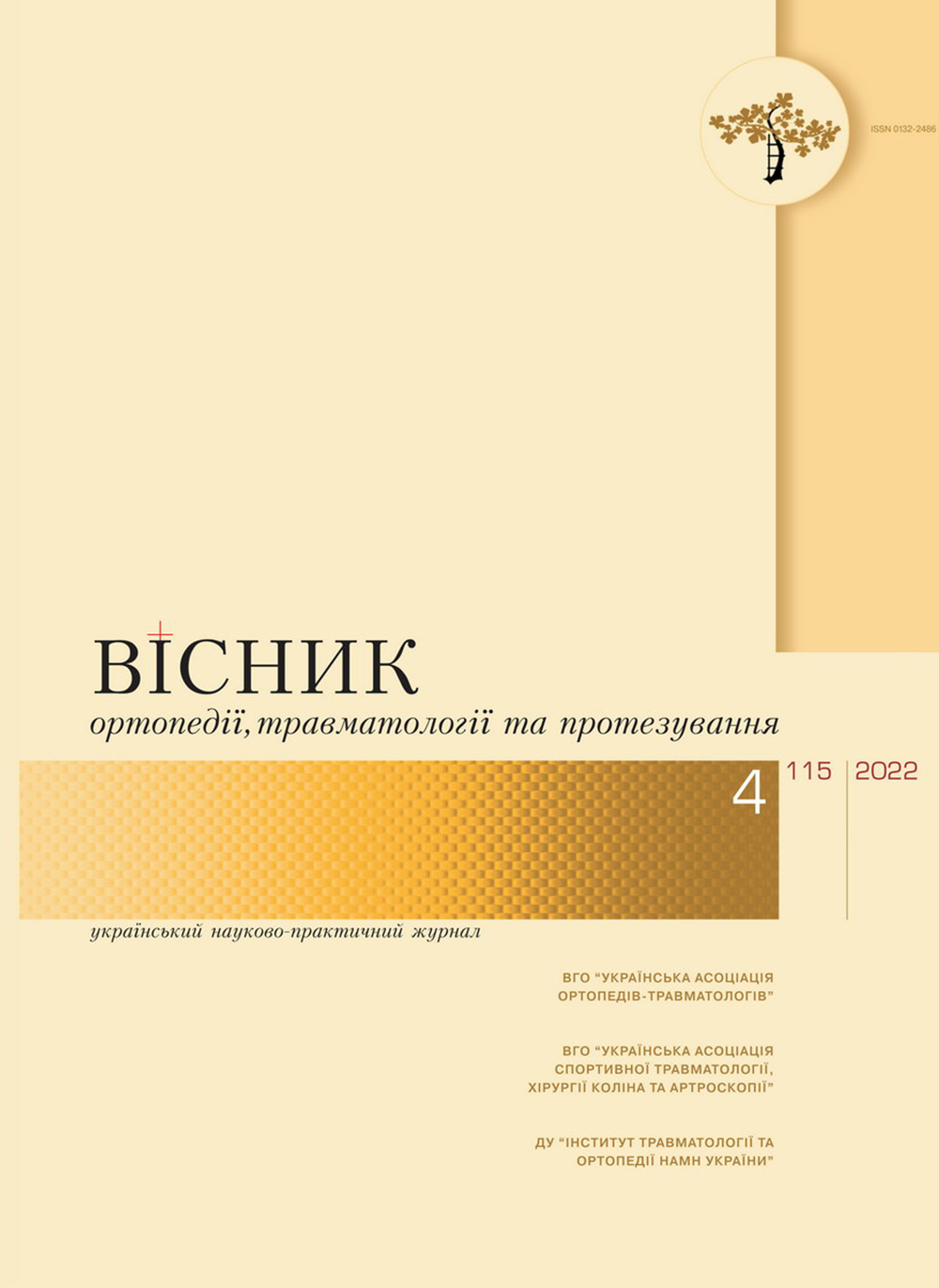Abstract
Summary. The frequency of damage to the distal metaepiphysis of the radius reaches from 16% to 33% of all fractures of the bones of the skeleton, and the increase in the incidence of osteoporosis definitely maintains the tendency to increase the frequency of damage to this localization. About 53.3% of the injured need repositioning; half of them (26.6%) have large unstable fractures of type B and C, which are subject to surgical treatment.
Materials and Methods. The study was carried out based on the materials of the trauma centers and trauma departments of the “City Clinical Hospital No. 2” of the DCC (Dnipro) and the MNPE “City Clinical Hospital No. 6” of the DCC (Dnipro). To assess the long-term consequences, a retrospective analysis of archive records of 318 patients with damage to the distal metaepiphysis of the radius was performed, including 271 radiographs of females (85.2%) and 47 males (14.8%).
Results. The conducted analysis gives grounds to state that remote manifestations depend on the nature and severity of fractures, the quality of reposition or surgical treatment. Fractures of type A and C have a pronounced tendency to develop manifestations of deforming arthrosis of the radiocarpal joint in the remote period after the injury, which may be due to the presence of incongruity of the articular surfaces against the background of residual “permissible” displacements of the fragments.
Conclusions. Ensuring accurate repositioning of fractures and expanding the indications for surgical treatment in case of “permissible” displacement of bone fragments in fractures of the distal metaepiphysis of the radial bone will reduce the frequency and severity of arthrosis in the remote period after the injury.
References
Strafun SS, Timoshenko SV. Fractures of the distal metaepiphysis of the radius. Kiev: Feniks; 2015. 307s.
Zazirnyi IM, Vasylenko AV. Biomechanical modeling in determining the strength of fixation of various types of implants in the treatment ofintra-articularfracturesof the distal metaepiphysis of the radius according to type C3 (biomechanical study). Travma. 2019;20(2):106-114. Available from: http://www.mifua.com/archive/article/47779.
Meena S, Sharma P, Sambharia AK, Dawar A. Fractures of distal radius:an overview. J Family Med Prim Care. 2014 Oct-Dec;3(4): 325-32. PMID: 25657938. DOI: 10.4103/2249-4863.148101
Al-Amin Z, Senyürek SA, Van Lieshout EMM, Wijffels MME. Systematic review and pooled analysis of the rate of carpal tunnel syndrome afterprophylacticcarpaltunnelrelease in patients with a distal radius fracture. Hand Surg Rehabil. 2018 Jun;37(3):155-159. PMID: 29580685. DOI: 10.1016/j.hansur.2018.02.004
Zazirnyi IM, Vasylenko AV. Modern methods of treatment of fractures of the distal metaepiphysis of the radius (literature review). Ortopediia, travmatolohiia ta protezuvannia. 2013;(3):107-112. Available from: http://nbuv.gov.ua/UJRN/ OpTlP_2013_3_24.
Burianov OA, Omelchenko TM, Sobolevskyi YuL. Prevention and treatmentofposttraumaticosteoarthritisinpatients with intra-articular osteochondral fractures. Travma. 2012;13(4):33-9.
Bentohami A, van Delft EAK & Vermeulen Jet al. Non- or minimally displaced distal radial fractures in adult patients: three weeks versus five weeks of cast immobilization a randomized controlled trial. J Wrist Surg 2019; 8:43-8.
Jerrhag D, Englund M, Karlsson MK, Rosengren BE. Epidemiology andtimetrendsofdistalforearmfractures in adults – a study of 11.2 million person-years in Sweden. BMC Musculoskelet Disord. 2017 Jun 02;18(1):240. PMID: 28576135. PMCID: PMC5457562. DOI: 10.1186/s12891-017- 1596-z
Loisel F, Bourgeois M, Rondot T, Nallet J, Boeckstins M, Rochet S, Leclerc G, Obert L, Lepage D. Treatment goals for distal radius fractures in 2018: recommendations and practical advice. Eur J Orthop Surg Traumatol. 2018 Dec;28(8):1465- 1468. PMID: 29663104. DOI: 10.1007/s00590-018-2196-9
Baruah RK, Islam M, Haque R. Immobilisation of extra- articular distal radius fractures (Colles type) in dorsiflexion: the functional and anatomical outcome. J Clin Orthop Trauma. 2015;6:167-72 .
Mellstrand Navarro C, Ahrengart L, Törnqvist H, Ponzer S. Volar locking plate or external fixation with optional addition of K-wires for dorsally displaced distal radius fractures: a randomized controlled study. J Orthop Trauma. 2016; 30: 217-24.
Matelenok YeM. Bets HV, Bets IH. Tactics of surgical treatment of fractures of the distal metaepiphysis of the bones of the forearm. Ortopedyia, travmatolohyia y protezyrovanye. 2011;(2):76-80.
Bets IH. Criteria for choosing technologies for the treatment of injuries to the distal metaepiphyses of the forearm bones. Travma. 2018;19(3).
Chen CN, Jupiter JP. Management of Distal Radial Fractures. J. Bone Joint Surg. Am. 2007;89:2051-2062.
Walenkamp MM, Aydin S, Mulders MA, Goslings JC, Schep NW. Predictors of unstable distal radius fractures: a systematic review and meta-analysis. J Hand Surg Eur Vol. 2016; 41:501–515.
Naumenko LYu, Vinnik AA. Results oftreatmentof fractures of the distal metaepiphysis of the radius. Travma. 2011;(2):25-29.

This work is licensed under a Creative Commons Attribution 4.0 International License.
